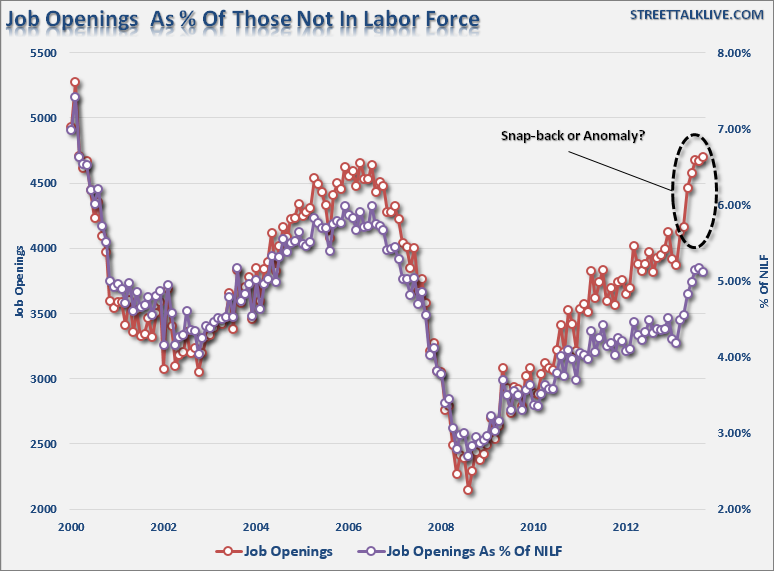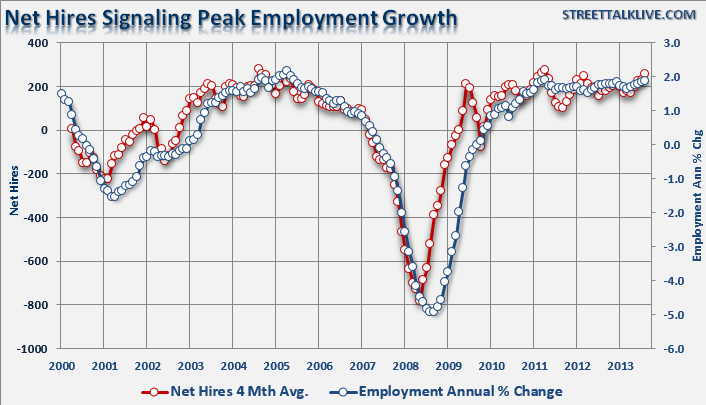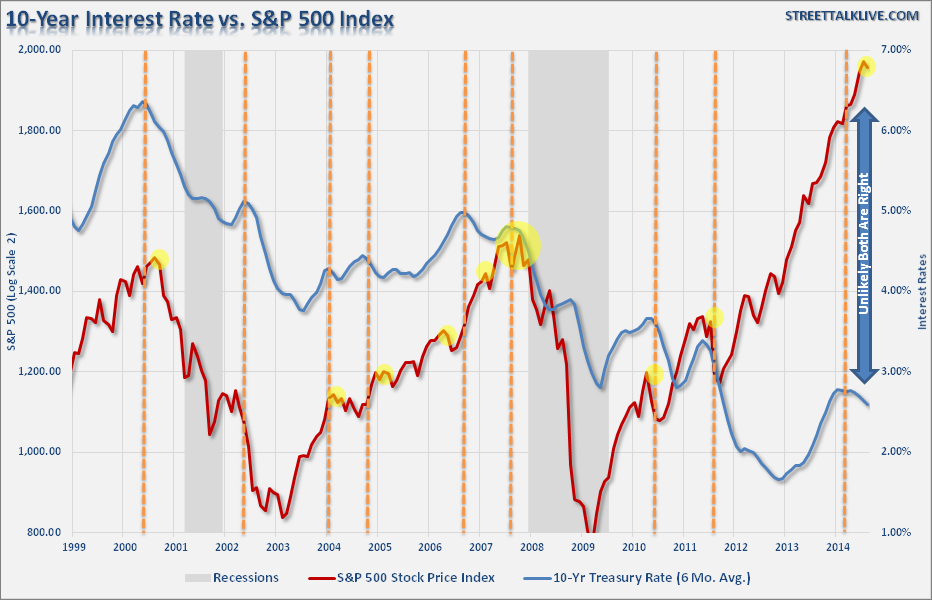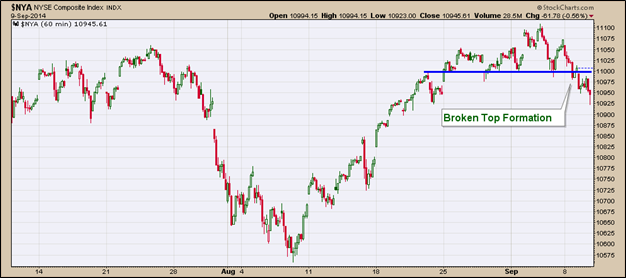A Day to Remember – September 11, 2001
On the 13th anniversary of September 11, our thoughts [were] once again with all those who lost loved ones on that tragic morning. It is important that we remember those whose lives were lost, not only in the tragedy of September 11th, but all those that have died defending the freedoms that are the embodiment of America.
Job Openings
“There’s good news for Americans looking for work: job openings are on the rise.”
That was the latest proclamation from CNN Money following the release of the latest Job Opening and Labor Turnover Survey from the Department of Labor. It is good news on the surface. However, as usual, single data points must be put into some form of reference, or they are meaningless.
First, there is a very anomalous spike in the data that has not previously occurred in the series as shown.
It could be a function of a temporary “snap-back” in demand following the extremely cold winter last year that led to a sharp drop in economic activity in the first quarter of this year. Or, it could be an anomaly in the data that is eventually revised away at some point in the future.
However, there are two other points to consider. Frist, the rise in job openings, which, unfortunately, are primarily focused in lower wage paying jobs, is not as strong as it appears considering the surge in individuals considered to be no longer part of the labor force (Not In Labor Force of NILF). The chart above shows job openings as a percentage of those sitting outside the labor force. Historically, there has been a fairly tight relationship between these measures as job openings would pull labor off of the sidelines and back into the labor force. However, since 2011 the gap has widened as the acceleration in those falling out of the labor force far exceed the number of available job openings.
Secondly, the rise in job openings, while an encouraging economic sign, is also at levels that have been normally more coincident with peaks of employment cycles and economic expansions. The chart below shows net hires (total hires less total separations – 4 mo. Average) as compared to annual percentage change in total employment. Considering that the current economic expansion is the fifth longest in the history, there is an argument that current levels of employment may indeed be indicative of “full employment.” If that is the case, it supports the theory that a “structural shift” in employment is the cause of the continued drag on economic growth.
Revisiting The Interest Rate/Equity Conundrum
I have discussed that the current divergence between interest rates and the equity markets was likely to be resolved quite painfully at some point.
“Both stocks and bonds cannot be right. While stocks have risen to new all-time highs in recent days, bond yields have fallen toward the lows of the year. As shown in the chart below, there has historically been a correlation between interest rates and the financial market from a risk on/risk off indication."
"It makes some sense given that when the markets have a preference for risk, asset allocations have shifted from bonds to equities and vice versa. As the demand for bonds falls, and the demand for stocks rise, yields rise. However, the current decline in yields, amidst a very low volume ramp-up in stock prices, suggests that the demand for safety is outweighing the demand for risk.
If historical correlations reassert themselves, the deviation between stock prices and bond yields will correct and likely not to the favor of the bulls.”
This idea was discussed by The Economist yesterday stating:
“If secular stagnation has set in, then yields could stay low for longer. And growth has been weak for a time.
But if you think that low bond yields can be justified by the secular stagnation story, what does that imply for the equity market? With the exception of the US, valuations do not look high (and some emerging markets, including China, look fairly cheap compared with their, admittedly short, history). In many cases, multinationals (investment grade companies) offer dividend yields that are higher than their corporate bond yields. But, again, Japan has shown us that prolonged stagnation eats away at stock market performance. And in the US, profits and margins are well above average levels. As Deutsche sagely says,
‘For valuations to be sustained and for equity returns to mirror those seen through history, at some point we need nominal GDP growth to improve on recent trends. The real problem for equity valuations will be if we continue in this low growth world for many years.’
There we have it; if bond yields are justified by low growth, equity valuations in the US are not justified.
Those who continue to act on the assumption that high returns can be achieved are storing up a lot of trouble.”
Quietly Breaking A Topping Formation
I have happy to announce that I am going to be able to start providing technical commentary to you from the illustrious Walter Murphy, Jr.* Yesterday, Walter discussed the recent break of a topping formation in the financial markets. To wit:
“On Tuesday the S&P 500 recorded its fifth loss in six sessions with a 0.65% decline to 1988. NYSE declining stocks exceeded winners by 5:1 while the up/down volume ratio was bearish by a bit less than 7:2. Turnover increased by 3%. The daily Coppock Curve has a bearish bias for 23 of the 24 S&P industry groups, for 27 of the 30 DJIA stocks, and for 84 of the stocks in the NASDAQ 100.
While last Friday’s weakness was deep enough to lock in the S&P’s August-September uptrend as a complete pattern, the reversal was not confirmed by broader indexes such as the S&P 1500, the NYSE Composite, or the Wilshire 5000. That is no longer the case; as a result of Tuesday’s weakness, all three of those indexes have reversed their respective August-September uptrends.”
Considering that there has not been a correction of any real magnitude since 2012; it is prudent to be aware that there is a risk of a deeper correction currently. On a positive note, longer term trends currently remain intact but that can, and does, tend to change quickly. As Walter suggests…”Stay Tuned.”




